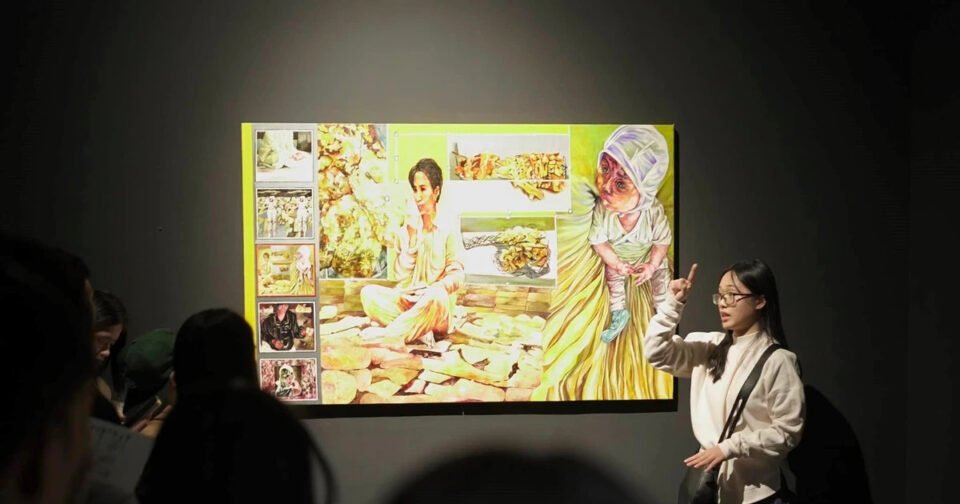After more than two vibrant years of activity, The Outpost – a major private contemporary art organization in Hanoi with 1,600 square meters of operational space in a bustling new urban area – officially “closed its doors” in early 2025.

Another gallery focused on contemporary art, launched in late 2023 in central Hanoi, has also quietly relocated.
These two venues – among the very few in Hanoi regularly showcasing Vietnamese contemporary art in a professional way – faced difficulties shortly after launch.
Yet beneath the surface, transactions in contemporary artworks continue quietly, prompting reflections on the commercial potential of Vietnam’s creative sector.
Does commercialization alter the meaning of art?
After years away from her practice to care for her family, artist N. returned with a widely praised solo exhibition in late 2023 in Hanoi.
Her work caught the attention of a foreign art foundation with offices in Vietnam, which later featured her in a major exhibition in China in late 2024 and supported her participation in a residency program.
These experiences reignited her artistic spirit and faith in the path she has chosen.
Still, N. admits to a lingering concern: “selling the work.” It’s not that there are no buyers. But her concept-driven exhibition presented itself as a single, unified artwork – large-scale fingerprint-based paintings in various shades of black, ceramic fragments laid out on the floor, and melted ancient relics transformed into unpredictable shapes by kiln heat.
The entire installation evoked reflections on historical and geographical continuity, human identity, and the universe across time.
Her hope was to find someone to acquire the work in its entirety. In the meantime, she sells individual pieces. Buyers include young domestic collectors.
But a single painting, once removed from the whole, simply hangs on a wall “looking nice” – a decorative gap filler.
She, like a fellow contemporary sculptor, has been encouraged to “break down” her large-scale work into smaller, sellable parts. His conceptually rich, three-dimensional installation spans nearly 6 meters in length and explores tensions between humanity and nature in the industrial age. Though made of modular components, removing just one block alters its meaning entirely. “It could become wall decor in a stylized bar,” he joked.
In Vietnam’s art circles, it’s no secret that some visual artists forge connections with architects. Installation works once touted as experimental art in solo exhibitions have reemerged as café decorations – curated by those very same architects moonlighting as collectors.
The need for formal guiding institutions
Contemporary art – fluid, boundary-breaking, and embracing interdisciplinary collaborations, including science and technology – is seen as a powerful expression of creativity, capable of igniting imagination and societal innovation.
One notable success is License 2 Draw by Vietnamese artist Uu Dam Tran Nguyen, which uses remote-controlled cars and a custom app to create drawings from anywhere in the world.
The project won the Jury Selection Award at the 2015 Japan Media Art Festival and was acquired by the Queensland Art Gallery (QAGOMA) for touring exhibitions across Australia.
More recently, visual artist Pham Minh Hieu represented Vietnam at the 15th Gwangju Biennale Pavilion (Sept 7 – Dec 1, 2024), showcasing a mixed-media installation blending physical objects, video, sound, and advanced technologies.
Singapore – despite being a small island nation – has successfully made its Singapore Biennale, organized by the National Arts Council, a global contemporary art destination, drawing tens of thousands of visitors per edition.
Vietnamese artists began exploring contemporary art in the early 1990s, enduring skepticism to pursue experimentation.
Only in late 2013 did Vietnam’s government officially recognize installation, performance, video, and body art as legitimate forms of fine arts through a Prime Ministerial Decree.
However, contemporary artworks are still not systematically collected by the Vietnam Fine Arts Museum or local public museums.
No formal domestic fund has been publicly designated to support contemporary art through grants, technical assistance, or acquisition.
Even in major national art events like the Vietnam Fine Arts Exhibition or the Young Artists Festival, contemporary artworks have increasingly become a minority, losing ground to conventional paintings and sculptures.
To date, most contemporary art efforts – whether in creation, coordination, media promotion, investment, or sales – remain self-driven by individual artists or a few private entities.
From the seemingly simple question of “who buys Vietnamese contemporary art” arises a broader challenge: how to fully unlock the immense value and creative potential of this field. It is time we stop wasting our own creative treasures.
Vietnam needs concrete mechanisms and policy frameworks to truly support and elevate contemporary art.
For example, establishing official funds for acquisition and sponsorship, offering tax incentives to encourage participation across sectors, and emphasizing the role of public institutions in arts education, audience development, and public collections.
These steps are crucial to ensure that Vietnamese contemporary art achieves the societal impact and global reach its talent deserves.
Nhan Dan

